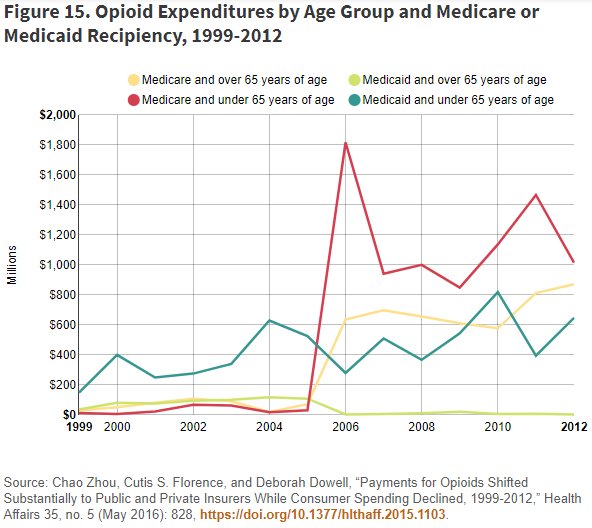Earlier this year, many conservative media commentators made note of an apparent correlation between rising opioid deaths and the Medicaid expansion-states under the Affordable Care Act, most citing this post by the pseudonymous blogger Spotted Toad. The crux of Mr. Toad’s post is the divergence in the overdose rate between expansion and non-expansion states between 2013 and 2015, as illustrated here:

*Note the truncated y-axis.
The first thing to note about the graphic, besides the truncated y-axis, is that the trends actually diverged in 2010-2011, before states began expanding Medicaid in 2014. And while 2013-2015 does seems correlated with a sharper upward turn in the trend, it’s an inflection that shows up in holdout states as well.
The already weak correlation is further called into doubt when opioid prescriptions under Medicaid are put in perspective with the rest of the U.S. healthcare system. A new, harrowing report from the Social Capital Project on “The Numbers Behind the Opioid Crisis” presents the following graph of the total expenditure on prescription opioids by insurance type:

The red line illustrates how the massive influx of opioids into the U.S. healthcare system has primarily been driven by Medicare Part D, enacted in 2006, while Medicaid’s share of prescriptions has remained pretty constant. As the authors of the report note, “opioid spending within Medicaid is presumably heavily concentrated among recipients of Supplemental Security Income (SSI) disability benefits, who were eligible for Medicaid before the Affordable Care Act passed.”
So if you want to blame a government program on the opioid crisis, look not to Medicaid, but to Medicare’s prescription drug program, which also supplies Social Security Disability Insurance (SSDI) for the under 65 crowd, and through which some 30 million Americans obtain opioids every year. Indeed, when researchers looked at the differential shock to the geographic supply of opioids following the enactment of Part D (using carefully controlled and instrumented regression analyses; not eyeballing some trend-lines), they found a corresponding increase in opioid-related deaths, including substantial spill-overs into the non-Medicare eligible population. From the abstract:
This relative expansion in opioid supply resulted in an escalation in opioid-related substance abuse treatment admissions and opioid-related mortality among the Medicare-ineligible population, implying meaningful spillovers to individuals who did not experience any change in prescription drug benefits. The evidence suggests that increased opioid supply is associated with economically-important levels of diversion for nonmedical purposes. Our estimates imply that a 10% increase in medical opioid distribution leads to a 7.4% increase in opioid-related deaths and a 14.1% increase in substance abuse treatment admission rates for the Medicare-ineligible population.
Emphasis added. As the authors point out, previous research has shown how the elderly population is a particularly easy target for younger opioid users, like friends and family, to whom their excess supply is diverted.
Unfortunately, with the Republican effort to repeal Obamacare and reform Medicaid, unsubstantiated speculation that Medicaid was the true driver of the opioid epidemic was too tempting for some, including Sam Adolphsen in NRO and Ross Douthat in NYTimes. Even Senator Ron Johnson got pulled in by the morass of misinformation.
As a result, we’ve continued to ignore the elephant in the room, Medicare Part D, in favor of attacking Medicaid, the key program for delivering rehabilitation and medically-assisted treatment programs to the very population the opioid epidemic is killing.